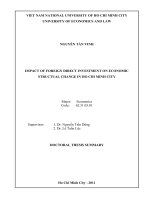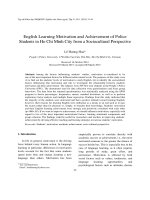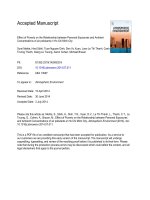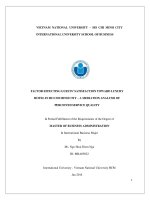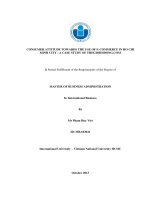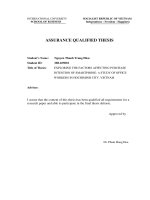Effect of employer branding on job application decisions of fresh graduates in ho chi minh city – a case study on retail enterprises
Bạn đang xem bản rút gọn của tài liệu. Xem và tải ngay bản đầy đủ của tài liệu tại đây (1.24 MB, 100 trang )
MINISTRY OF EDUCATION AND TRAINING THE STATE BANK OF VIET NAM
BANKING UNIVERSITY OF HO CHI MINH CITY
TRIEU DOAN NGAN DAO
EFFECT OF EMPLOYER BRANDING ON JOB
APPLICATION DECISIONS OF FRESH GRADUATES
IN HO CHI MINH CITY – A CASE STUDY ON RETAIL
ENTERPRISES
BACHELOR THESIS
MAJOR: BUSINESS ADMINISTRATION
CODE: 7340101
HO CHI MINH CITY, 2021
MINISTRY OF EDUCATION AND TRAINING THE STATE BANK OF VIET NAM
BANKING UNIVERSITY OF HO CHI MINH CITY
TRIEU DOAN NGAN DAO
EFFECT OF EMPLOYER BRANDING ON JOB
APPLICATION DECISIONS OF FRESH GRADUATES
IN HO CHI MINH CITY – A CASE STUDY ON RETAIL
ENTERPRISES.
BACHELOR THESIS
MAJOR: BUSINESS ADMINISTRATION
CODE: 7340101
SUPERVISOR
PHAM HUONG DIEN, Ph.D
HO CHI MINH CITY, 2021
i
ABSTRACT
In increasing competitive labour markets, attracting candidates has become a
prime concern of organizations. Fresh graduates is known as potential employee for the
employer. Fresh graduates having new ideas, knowledge can contribute to the
development of the company. So the employers need to identify and understand the
range of factors that affect job application decisions of this potential human capital. In
this study, I hypothesize that organizational size, compensation and benefits, training
and development, corporate reputation and word of mouth that influence the decisionmaking of fresh graduates. Using regression analysis, I demonstrate that fresh
graduates is impacted by training and development opportunities, corporate reputation
and word of mouth. In particular, the corporate reputation is the most attractive
component for prospective candidates. Besides that, organizations should develop
many training and development programs for employee because fresh graduates prefer
working in a company where they can learn and develop new skills and knowledge.
The results suggest that firms should develop employer branding and communicate
values that company brings for customers, employees and social communities to attract
the attention of potential applicants.
Key words: employer branding, fresh graduates, job application decisions,
retail enterprise.
ii
DECLARATION OF AUTHENTICITY
I the undersigned declare that all material presented in this paper is my own
work or fully and specifically acknowledged wherever adapted from other
sources.
I understand that if at any time it is shown that I have significantly
misrepresented material presented here, any degree or credits awarded to me on
the basic of that material may be revoked.
I declared that all statements and information contained herein are true,
correct and accurate to the best of my knowledge and belief.
Ho Chi Minh City, June 2021
Trieu Doan Ngan Dao
iii
ACKNOWLEDGEMENT
I would like to take this opportunity to acknowledge serveral individuals who
have helped me to complete my thesis.
Frist of all, I would like to express my endless thanks and gratefulness to my
supervisor Ph.D Pham Huong Dien. Her kindly and continuous advices through the
process of completion of my thesis. Her encouragement and comments had
significantly enriched and improved my work. Without her motivation and instruction,
the thesis would have been impossible to be done effectively.
Secondly, I want to thanks my family for their endless love, care, and have most
assistant and motivation me for the whole of my life.
Next, my deeply thanks come to all of my friends who always support me during
time I study in Banking University of Ho Chi Minh City. I am thankful for the times
and they have listened to me, advised me and even comforted me. Their kindly helps,
care and motivation gave me strength and lift me up all the trouble for the rest of my
life.
Ho Chi Minh City, June 2021
Trieu Doan Ngan Dao
iv
TABLE OF CONTENTS
LIST OF TABLES ....................................................................................................... viii
LIST OF FIGURES.......................................................................................................... x
CHAPTER 1: INTRODUCTION .................................................................................... 1
1.1.
Research neccessity ............................................................................................ 1
1.2.
Research objectives and questions ..................................................................... 1
1.2.1.
Research objectives...................................................................................... 1
1.2.2.
Research questions ....................................................................................... 2
1.3.
Research scopes and subjects ............................................................................. 2
1.3.1.
Research scopes ........................................................................................... 2
1.3.2.
Research subjects ......................................................................................... 2
1.4.
Research methodology ....................................................................................... 3
1.5.
Expected contributions ....................................................................................... 3
1.6.
Thesis structure ................................................................................................... 3
1.7.
Conclusion .......................................................................................................... 5
CHAPTER 2: LITERATURE REVIEW ......................................................................... 6
2.1.
Important concepts. ............................................................................................ 6
2.1.1.
Branding. ...................................................................................................... 6
2.1.2.
Employer branding. ..................................................................................... 6
2.1.3.
Retail enterprise ........................................................................................... 8
2.1.4.
Fresh graduates. ........................................................................................... 9
2.2.
Theoretical models and the previous studies .................................................... 10
2.2.1.
The theoretical models ............................................................................... 10
2.2.1.1.
Theory of Reasoned Action (TRA)..................................................... 10
2.2.1.2.
Theory of Planned Behaviour (TPB) .................................................. 11
2.2.1.3.
The career decision making model ..................................................... 12
2.2.1.4.
The job choice model .......................................................................... 13
v
2.2.1.5.
2.2.2.
The Model of Career Decision Making for College Students ............ 15
The previous researches ............................................................................. 18
2.2.2.1.
The research ―Factors influencing the job search and job selection in
students of Generation Y in the Czech Republic in the employer branding
context‖ 18
2.2.2.2.
The research ―Captivating company: dimensions of attractiveness in
employer branding‖. ............................................................................................ 19
2.2.2.3.
The research ―A great place to work!? Understanding crowdsourced
employer branding‖. ............................................................................................ 21
2.2.2.4.
The research ―Employer Brand and Job Application Decisions:
Insights from the Best Employers‖. ..................................................................... 23
2.3.
Research hypotheses and the research model ................................................... 25
2.3.1.
2.3.1.1.
Organizational size. ............................................................................. 25
2.3.1.2.
Compensation and benefits. ................................................................ 25
2.3.1.3.
Training and development. ................................................................. 26
2.3.1.4.
Corporate reputation. .......................................................................... 26
2.3.1.5.
Word of mouth. ................................................................................... 27
2.3.2.
2.4.
Research hypotheses .................................................................................. 25
The proposed research model. ................................................................... 29
Conclusion ........................................................................................................ 30
CHAPTER 3: METHODOLOGY ................................................................................. 31
3.1.
Process of research ........................................................................................... 31
3.2.
Qualitative research .......................................................................................... 31
3.2.1.
Qualitative research methods ..................................................................... 31
3.2.2.
The qualitative research result ................................................................... 33
3.3.
Quantitative research ........................................................................................ 35
3.3.1.
Scale ........................................................................................................... 35
vi
3.3.2.
Research sample design ............................................................................. 36
3.3.3.
Questionnaire design.................................................................................. 37
3.3.4.
Research data collection ............................................................................ 37
3.3.5.
Data processing and analysis ..................................................................... 38
3.4.
3.3.5.1.
Data checking and cleaning. ............................................................... 38
3.3.5.2.
Descriptive statistics ........................................................................... 38
3.3.5.3.
The reliability of scale......................................................................... 38
3.3.5.4.
Explored Factor Analysis .................................................................... 39
3.3.5.5.
Linear Regression Analysis and hypothesis testing ............................ 40
3.3.5.6.
Robust check ....................................................................................... 42
Conclusion ........................................................................................................ 42
CHAPTER 4: DATA ANALYSIS ................................................................................ 43
4.1.
Describing data ................................................................................................. 43
4.2.
Reliability Analysis .......................................................................................... 45
4.3.
Explored Factor Analysis ................................................................................. 47
4.3.1.
Explored Factor Analysis for Independent Variables ................................ 47
4.3.2.
Explored Factor Analysis for Dependent Variable .................................... 48
4.4.
Correlations Analysis ....................................................................................... 50
4.5.
Regression Analysis ......................................................................................... 52
4.5.1.
Analysis the fit of model ............................................................................ 52
4.5.2.
Coefficients Analysis ................................................................................. 53
4.5.3.
Testing Autocorrelation ............................................................................. 55
4.5.4.
Testing Collinearity ................................................................................... 55
4.5.5.
Testing Normal Distribution of Residual .................................................. 56
4.5.6.
Testing Heteroskedasticity......................................................................... 56
4.6.
Robust Check .................................................................................................... 57
4.6.1.
The difference about gender ...................................................................... 57
vii
4.6.2.
The difference about qualifications ........................................................... 58
4.6.3.
The difference in job application decisions by graduation status .............. 59
4.7.
Conclusion ........................................................................................................ 60
CHAPTER 5: CONCLUSION AND IMPLICATIONS ................................................ 62
5.1.
Summarize the research result .......................................................................... 62
5.2.
Implications ...................................................................................................... 63
5.3.
Limitations and orientations for further studies ............................................... 64
5.4.
Conclusion ........................................................................................................ 65
REFERENCES ............................................................................................................... 66
APPENDIX 1 ..............................................................................................................lxxv
APPENDIX 2 ..............................................................................................................lxxx
APPENDIX 3 ............................................................................................................lxxxv
viii
LIST OF TABLES
Table
Table 2.1
Name
Summary the conceptions of career decision-making process
Page
12
Table 2.2
Summary the characteristics of career decision-making process
15
Table 2.3
Five elements in employer brand development
20
Table 2.4
Seven key employer branding areas
22
Table 2.5
Summary the research hypotheses
29
Table 4.1
Frequency statistics for study sample
43
Table 4.2
Summary the Reliability Statistics
45
Table 4.3
KMO and Bartlett's Test for Independent Variables
47
Table 4.4
Factor loading for Independent Variables
47
Table 4.5
KMO and Bartlett's Test for Dependent Variable
48
Table 4.6
Component Matrix for Dependent Variable
48
Table 4.7
Summarize the research scales after analyzing EFA
49
Table 4.8
Correlations between Dependent Variable and Independent
51
Variables
Table 4.9
Model Summary
52
Table 4.10 Test for the fit of regression model
52
Table 4.11 Coefficients Analysis for Independent Variables
53
Table 4.12 Testing Autocorrelation
55
Table 4.13 Testing Collinearity
55
Table 4.14 Correlations between ABSRES and independent variables
56
Table 4.15 Comparing the job application decisions by gender group.
57
Table 4.16 Independent Test for gender groups
57
Table 4.17 Comparing the job application decisions by qualifications
58
group.
ix
Table 4.18 Independent Test for qualification groups
59
Table 4.19 Test of Homogeneity of Variances of Graduation Status,
59
Table 4.20 Test of ANOVA for the difference by groups of Graduation
60
Status
x
LIST OF FIGURES
Figure
Name
Page
Figure 2.1
The supply chain model
8
Figure 2.2
The Theory Reasoned of Action Model
10
Figure 2.3
The Theory of Planned Behaviour Model
12
Figure 2.4
The Job Choice process
14
Figure 2.5
The career decision-making process
15
Figure 2.6
The research model
29
Figure 4.1
Histogram Chart
54
Figure 4.2
Histogram Chart
56
1
CHAPTER 1: INTRODUCTION
1.1. Research neccessity
These days, fresh graduate students not only interested in salary but also care
about their training and development programs and experiences at work,…when they
make a job application decisions. According to Ambler and Barrow (1996), employer
branding communicates the benefits of employment to potential candidates. Potential
employees use employer branding to differentiate between employers and assists their
decision making. Information that potential employees gain about an employer forms
the image they attribute to the brand of an organisation.
Also, in increasingly competitive labour markets, attracting and retaining talent
has been one of the prime concerns of organisations, employer branding is considered
as a significant factor that attracts the human resources that best fits and contributes to
the strategic aims and bottom line of organisations. Besides that, when an enterprise
deployments an employer branding that will help the company construct a sustainable
brand image which is considered a competitive advantage for the company. However,
to create a sustainable strong, genuine and lasting employer brand, employers need to
understand the range of factors that influence career decision making and the role of
employer branding in attracting human capital that best fits and contributes to the
strategic aims of an organisation. Thus, this paper aims to identify the employer
branding factors affecting job application decisions of fresh graduate students in Ho
Chi Minh City – a case study on retail enterprises.
1.2. Research objectives and questions
1.2.1. Research objectives
The overall objective:
To research the influence of the employer branding factors on the job application
decisions of fresh graduates into enterprises in the retail industry in Ho Chi Minh City.
2
The specific objectives:
- To identify the employer branding factors that affect the application decisions of
recent graduate students into companies in the retail industry.
- To evaluate and measure the effect of employer branding factors on job
application decisions of recent university graduates.
- To propose managerial implications supporting the firms in the retail industry to
improve their employer branding to attract talented candidates.
1.2.2. Research questions
- What are the factors of employer branding which affect the decisions to apply
for a job in retail industry of fresh university graduates?
- How are these factors influencing the job application decisions of new graduates
into the retail enterprises?
- What are the managerial implications that can be concluded from this study for
the retail firms to attract the talent among the graduate students?
1.3. Research scopes and subjects
1.3.1. Research scopes
Fresh graduates define as students who have just graduated from university or
college, or people who graduated but having less than two years of working
experience. So this research is focused on people who are:
- Final year students preparing for graduation;
- Just graduated;
- Graduated having less than 01 years of working experience;
- Graduated having less than 02 years of working experience.
1.3.2. Research subjects
This study targets mainly on the employer branding‘s factors that influence job
application decisions of recent university graduates. To obtain the target, the author
3
conducts a survey data on the fresh university graduates who have less than two years
of working experience and desire to work in the retail industry in Ho Chi Minh City.
1.4. Research methodology
This study conducts both quantitative research methods and qualitative research
methods. In qualitative research methods, the author build questionnaire basing on
questionnaire in relevance previous researches. Additionally, in quantitative research
methods, author uses a non-probability sampling method with an accidental sampling
design to collect data. The respondents receive the questionnaire survey and answer all
the questions based on their experience, using a 1–5 Likert-type scale with an anchor of
1 for ―strongly disagree‖ to 5 for ―strongly agree‖.
1.5. Expected contributions
Practical contribution:
- Provide a comprehensive, reliable and comprehensive source of information for
employer branding activities of retail enterprises.
- Research results help businesses identify the level of employer branding effect
on job application decisions of fresh graduates
Academic contribution:
- The research model is constructed basing on the previous research hypotheses
and research model about the effect of employer branding on career making-decision.
So the result of this research will contribute to the consolidation of previous research.
- The experience gained during the research process is the basis for the
completion and implementation of research activities on the impact of employer
branding in future researches.
1.6. Thesis structure
Besides table of contents and references, this thesis has five chapters.
4
- Chapter 1: Introduction
This chapter focuses on the overview of the research by setting research
problems, identify the necessity of research, the research subject, the research
contribution and the research objective. These topics provide the overview of the
research content and setting a base for researching theoretical background in the next
chapter.
- Chapter 2: Literature review.
Chapter two present the concept of employer branding, the factors of employer
branding, the application process, the theoretical models and the previous researches.
These theories are the basis for suggesting the research model of the effect of employer
branding on the job application decisions of recent graduate students into retail firms in
Ho Chi Minh City.
- Chapter 3: Research methodology
Chapter three provides information about the research methodology including the
research design, samples collection and statistical data analysis technique.
- Chapter 4: Research result
This chapter shows the research result after data analysis using SPSS 20 software.
This chapter includes six main points: describe the sample, statistic for nominal scales,
descriptive statistic for ordinal scales, reliability statistics for the dependent variable
and independent variables, factor loading analysis for independent variables, dependent
variable and coefficients analysis of independent variables and analyze the meaning of
research result.
- Chapter 5: Conclusions
Chapter five summarises the research result and proposes the governance
implications to improve and advance the employer branding of retail companies to
attract more candidates. Besides that, the limitation of research is also mentioned in
this chapter
5
1.7. Conclusion
This chapter presents the neccessity of this research, identifies the research
objectives and questions to clarify the research problem. Besides that, this chapter give
an overview about the research methods using in this study, which will discuss later in
chapter 3. Finally, this chapter briefly presents the structure of this thesis.
6
CHAPTER 2: LITERATURE REVIEW
2.1. Important concepts.
2.1.1. Branding.
There are many ways to understand the concept of branding. First of all, the term
―branding‖ entered in marketing in 1922, which known as a compound expression (i.e.
brand name) meaning a trade or proprietary name (Stern, 2006). According to
Woodside and Walser (2007), the concept ―brand‖ was known as an encompassing
concept that includes retail firms as well as physical products and services. As stated
by Bastos and Levy (2012), the term ―branding‖ started as a sign, a way of denoting
that an object was what it was and then became a form of naming something.
According to Schneider (2003), a brand was defined as ―a name, term, sign, symbol, or
design, or combination of them which is intended to identify the goods and services of
one seller or group of sellers and to differentiate them from those of competitors‖.
2.1.2. Employer branding.
There is the truth that all employers have a brand, but not all employers engage
effectively in branding efforts to differentiate themselves as employers. The purpose of
employer branding is to show a positive and attractive image to current and potential
employees. Furthermore, employer branding considers as one of many reputational
factors that adds to competitive advantage. There are several definitions of the concept
of employer branding.
First of all, in 1996, Ambler and Barrow introduced the term employer branding
into the lexicon of human resource management. The term ―employer branding‖ was
defined as ―the package of functional, economic and psychological benefits provided
by employment and identified with the employing company‖. Moreover, employer
branding applied marketing techniques to the process of recruiting and retaining
employees. According to The Conference Board (2001), the employer brand
considered as "the company's value system, the policies and the behaviour that helped
7
the company attract, motivate and retain current or potential employees". Additionally,
in Backhaus and Tikoo‘s research (2004), the concept of employer branding suggested
the differentiation of a firms‘ characteristics as an employer from those of its
competitors. The employment brand highlighted the unique aspects of the firm‘s
employment offerings or environment. Moreover, the employer branding described to a
corporation‘s image and reputation as an employer and its value proposition to its
human resources (Barrow and Mosley, 2011). In 2011, Martin and his colleagues
defined the term employer brand as ―a generalized recognition for being known among
stakeholders for providing a high quality employment experience, a distinctive
organizational identity which employees value, engage with and feel confident and
happy to promote to others‖. According to Kucherov and Zavyalova (2012) described
the employer brand as ―qualitative features of the employing company, which attracted
target audience with positive image and appropriate set of material and non-material
advantages distinguishing a company in the labour market‖. Furthermore, the employer
branding contained the principles, practices and tools by which an enterprise
influenced its image, reputation and brand as an employer, among current and potential
employees (Lane, 2016).
Regarding this, Martindale (2010) said that employer branding and HR marketing
are considered meaningful conception for responding to recruitment and retention
issues in today's firms. Additionally, Stuss and Herdan (2017) had mentioned that
employer branding was a significant part of the long-term corporate strategy so that
firms would try managing the perceptions and awareness of current human resources or
potential employees. Besides that, Urbancová and Hudáková (2017) mentioned that
marketing and employer branding could bring new opportunities and changes in these
fields. As posited by Ritson (2002), the employer branding had serveral benefits to
companies such as reducing cost of employee acquisition, improving employee
relations, increasing employee retention and offering lower salaries for comparable
8
staff to firms with weaker employer brands. Beside that, Berthon and his colleagues
(2005) mentioned that corporations had ‗high employer brand value‘ were perceived by
potential employees as more attractive than those with lower employer brand value.
2.1.3. Retail enterprise
Retail businesses acting within distribution channels are becoming bigger and
bigger as the result of a process of association and integration in the channel, leading to
an increase in their negotiating power as well. (Santos-Requejo, L., & GonzálezBenito, Ó., 2000). As stated by Ayers and Odegaard in the book ―Retail supply chain
management‖ (2019), the term ―retail‖ described as final sales to mostly nonbusiness
customers or consumers. Besides the nonbusiness customer, most businesses also made
purchase at retail stores. So the there are two main transactions in retail company that
are business-to-customer (B2C) or business-to-business (B2B). The position of retail
enterprise in supply chain illustrates through picture figure 2.1:
Supplier
Manufacturer
Distributor
Retailer
Customer
Figure 2.1. The supply chain model
Source: Ayers, J. B., & Odegaard, M. A. (2019)
In this research, retailer is known as origin equipment manufacture (OEM) so
supplier, manufacturer and distributor are considered as supplier (buy side of supply
chain) and customer refers to sell side stream. The retailer purchase products from
distributors or manufacturers, then sell it to customer, the profit of retailer is equal to
(―the sale price‖ - ―the purchase price‖) * the quantity of selling products. There are
many types of retailers that specialize in various sales techniques and carter to different
consumer types such as: department stores, gocery stores and supermarket, warehouse
retailers, specialty or outlet retailers, convenience retailer and internet or mobile
retailer.
9
There are four main characteristics of the retailer. First of all, retailers supplied
various kinds of goods so that everyone can choose and buy. Next, the retailer bought
goods from manufacture or distributor in large quantities, and the retailer divided
goods into smaller sizes or consumable sizes. Third, retailers hold inventory close by
and provide convenience to the customer. Besides bringing the product to the
customer, retailers also supplied services to enhance the value of this product. To
become a successful retailer, the retailer had to do three things well. Firstly, the retail
company must recognize the niche or market segment for their offerings among all
available market segments to decide the target market with an opportunity for growth.
Next, the retailer must design and develop a retail format that is suitable and effective
with the target market.
2.1.4. Fresh graduates.
Fresh graduates is known as potential employee for the employer. Fresh graduates
having new ideas, knowledge can contribute to the development of the company. There
are several definitions of fresh graduates but no one fixed identity for this concept.
According to Cabellero and Walker (2010), the concept ―graduates‖ was defined as
former students who had received an undergraduate or postgraduate university or
college degree. In their article, they mentioned that fesh graduates was the person who
had completed an undergradute degree and were entering professional employment for
the first time. Additionally, Borghans and Golsteyn (2012), fresh graduates is college
graduates whose work experience in the first three years after graduation. On the other
hand, fresh graduates is an employer who has been employed for less than two years, is
considered an entry-level employee in organizations (Anas and Hamzah, 2020).
According to Mansor and his colleagues (2014), many enterprises were in
difficulties recruiting fresh graduates because of time constraints. The students who
had applied occupied with their assignment as well as their activities. As a result, the
10
students could not apply for the job vacancies since this requires preparing the
necessary documentation to be mailed to the appropriate companies.
2.2. Theoretical models and the previous studies
In this section, the author discusses relevant theoretical models (TRA, TPB), the
career decision-making models, the process of career decision-making. Besides that,
the author will build the research hypotheses and model basing on referencing the
relevant previous research.
2.2.1. The theoretical models
2.2.1.1.
Theory of Reasoned Action (TRA)
Behavioural
Beliefts
Outcomes
Evaluation
Attitude toward
Behaviour
Intention
Behaviour
Normative
Beliefs
Subjective Norms
Motivation
to Comply
Figure 2.2. The Theory Reasoned of Action Model
Source: Fishbein, M., & Ajzen, I. (1977)
The theory of reasoned action based on the assumption that human beings usually
behaved sensibly, and took account of available information and implicitly or explicitly
considered the implications of their actions. Fishbein and Ajzen (1977) mentioned that
person's intention was a function of two determinants: personal and reflecting social
influence. The personal factor was the individual's positive or negative evaluation of
performance behaviour that termed attitude toward the behaviour. The beliefs that
11
underlain a person's attitude toward the behavior were termed behavioral beliefs.
Besides that, people intended to perform a behaviour when they evaluated it positively
and believed that necessary others thought they have to do it. The second determinant
was the person's perception of the social pressures put on him to perform or not
perform the behaviour in question that termed subjective norm. These beliefs
underlying the subjective norm were termed normative beliefs. Generally speaking, a
person who believed that most referents with whom he was motivated to comply
thought he had to perform the behavior would perceive social pressure to do so.
2.2.1.2.
Theory of Planned Behaviour (TPB)
Ajzen (1985) developed the theory of planned behaviour (TPB) based on the
theory of reasoned action of Ajzen and Fishbein (1977). Both theories explained that a
person‘s intention to perform a certain behavior influences actual subsequent
behaviours. The theory of planned behavior (Ajzen, 1985) suggests that there are three
conceptually independent determinants of behavioral intentions.
The first determinant was the person‘s attitude toward the behaviour, referring to
the positive or negative evaluation of performing the behaviour. The second
determinant was the subjective norm, reflecting the person‘s perception of social
pressure regarding the performance of the behaviour. The third determinant was
perceived behavioural control (PBC), which refered to the person‘s perception of
control over performance of the behaviour. This reflected past experience as well as
anticipated impediments and obstacles. Finally, personal or moral norms also guided
intentions and behaviours.
12
Person‘s
attitude toward
the behaviour
Subjective
norm
Intention
Behaviour
Perceived
behavioural
control
Figure 2.3. The Theory of Planned Behaviour Model
Source: Ajzen, I. (1985)
2.2.1.3.
The career decision making model
According to Hilton (1962), career decision-making was an imperfect process at
best. There were five possible conceptions of the career decision-making process: the
attribute-matching model; the need-reduction model; the problem gain model; the
social structure model and the complex information processing model. The
characteristics of these model is summarized in table 2.1.
Table 2.1. Summary the conceptions of career decision-making process
Model
Characteristics
- The simplest form of making career decision
- Implicited in this personality-and-factor approach, which emphasized
The
individual differences and how they could impact the process of
attribute
employment choice
matching
- The candidate first searched and listed all of his personal attributes.
model
Then he ascertained the attributes required for successful adjustment in
each of some set of employments, and he selected employement
requirements that best matched his attributes.
The need
- The approach to career development associated with dynamic
13
reduction
personality theory, which goal was to reduce need tension.
- With varying degrees of awareness of their behaviour, the candidate
model
sought out occupations that satisfy their needs. Then the candidate
appraised his own needs and estimated the need-reducing value of
some set of alternatives.
- This model provided a basis for comparing the attractiveness of
different ones, namely their drive-reducing perspective.
The problem
gain model
- The candidate faced many alternatives, and each of these had
certainly outcomes that had a positive value to his/her. Besides that,
these alternatives had a certain probability of happening.
- The model emphasized that the mobility provided and the limits
The social
imposed by the many social structures through which an individual's
structure
career carried him.
- The candidate evaluated what outcomes he/she valued the most and
model
the entrance requirements that he thought these enough to pay
The complex
information
processing
model
- The individual faced multitudinous behavioural alternatives and selflimited capacity to handle information about ones that limited the
rationality of decision-making.
- The candidate could search for those outcomes which were
satisfactory and searched for a behavioural alternative
Source: Hilton, T. L. (1962).
2.2.1.4.
The job choice model
In the research ―Job choice and Post Decision Dissonance‖ (1975), Lawler and
his colleagues applied an expectancy theory approach to job choice. First, the Effort to
Performance expectancy refered to the probability that a person could perform the
intended behaviour such as obtaining job. Second, Performance to Outcome refered to
the probability that certain outcomes would result from the previous behaviour, for


